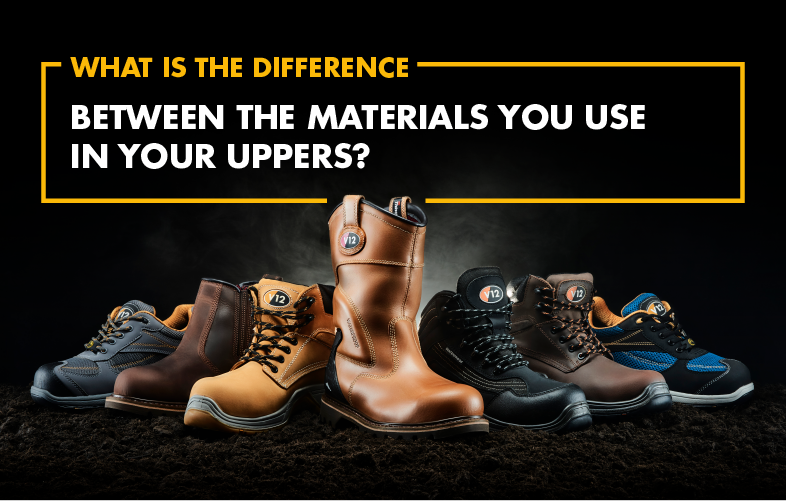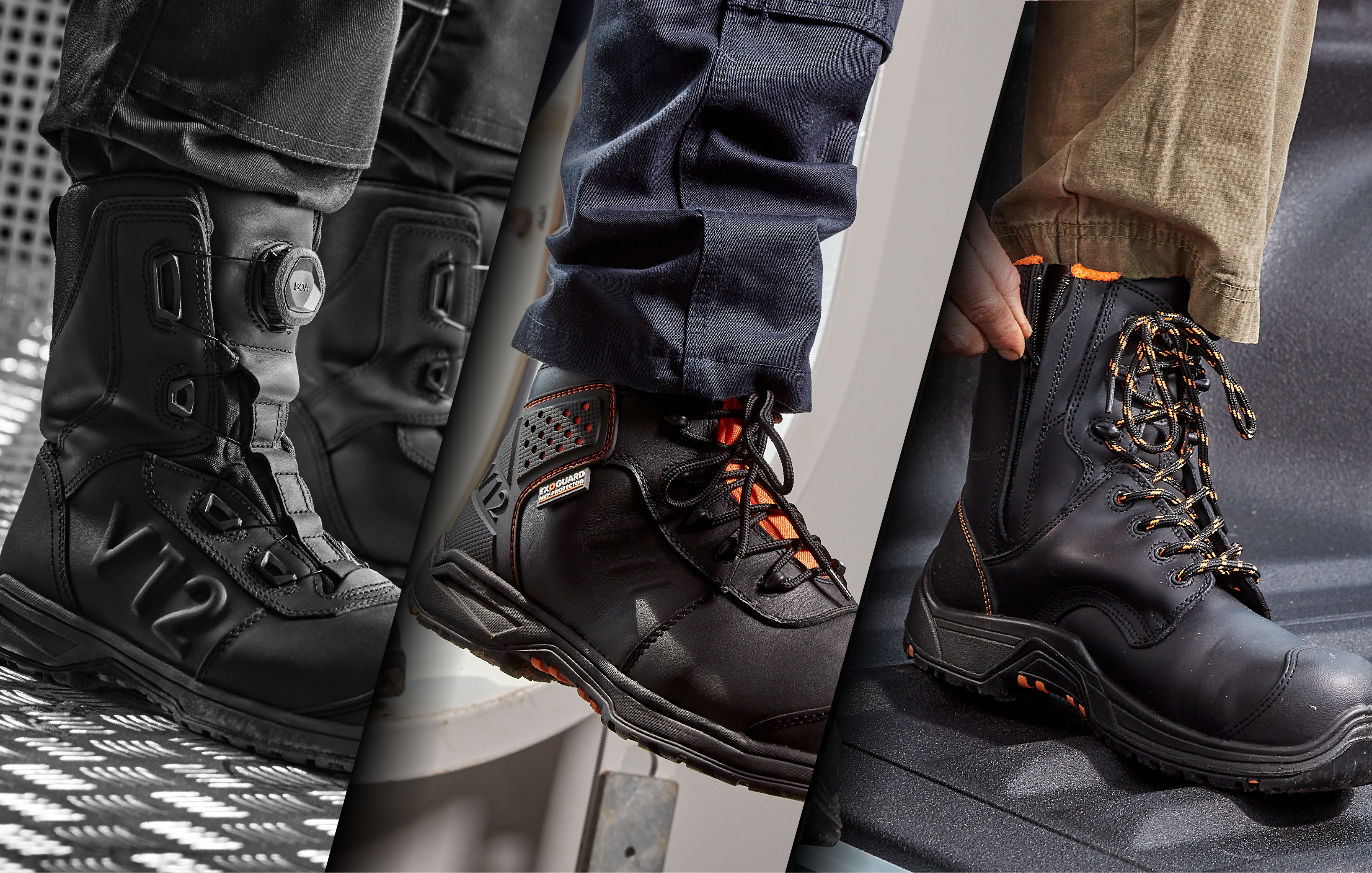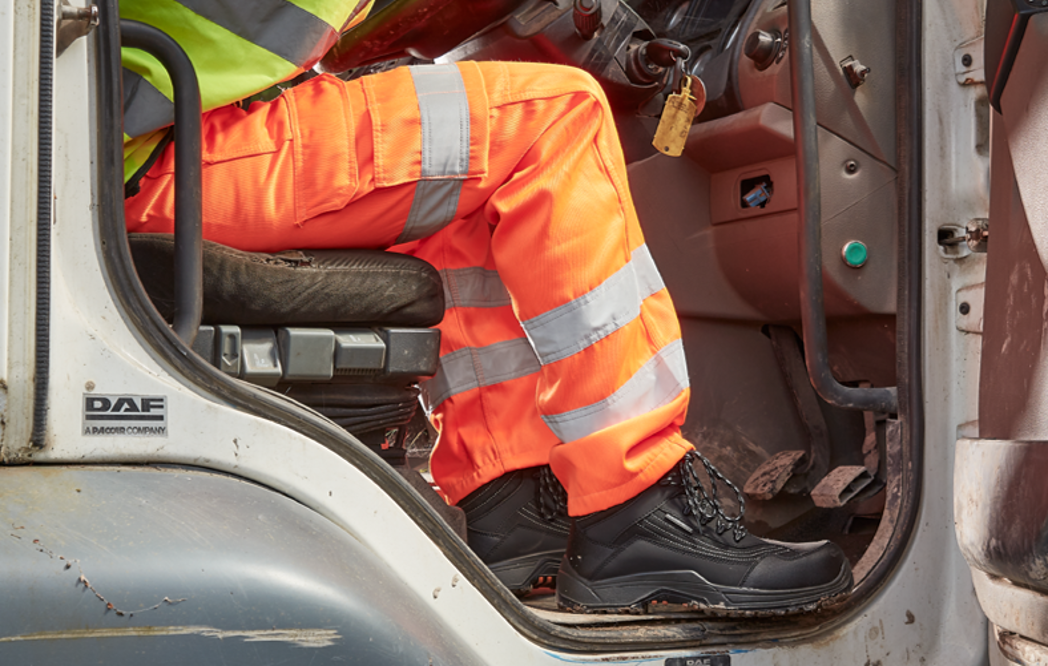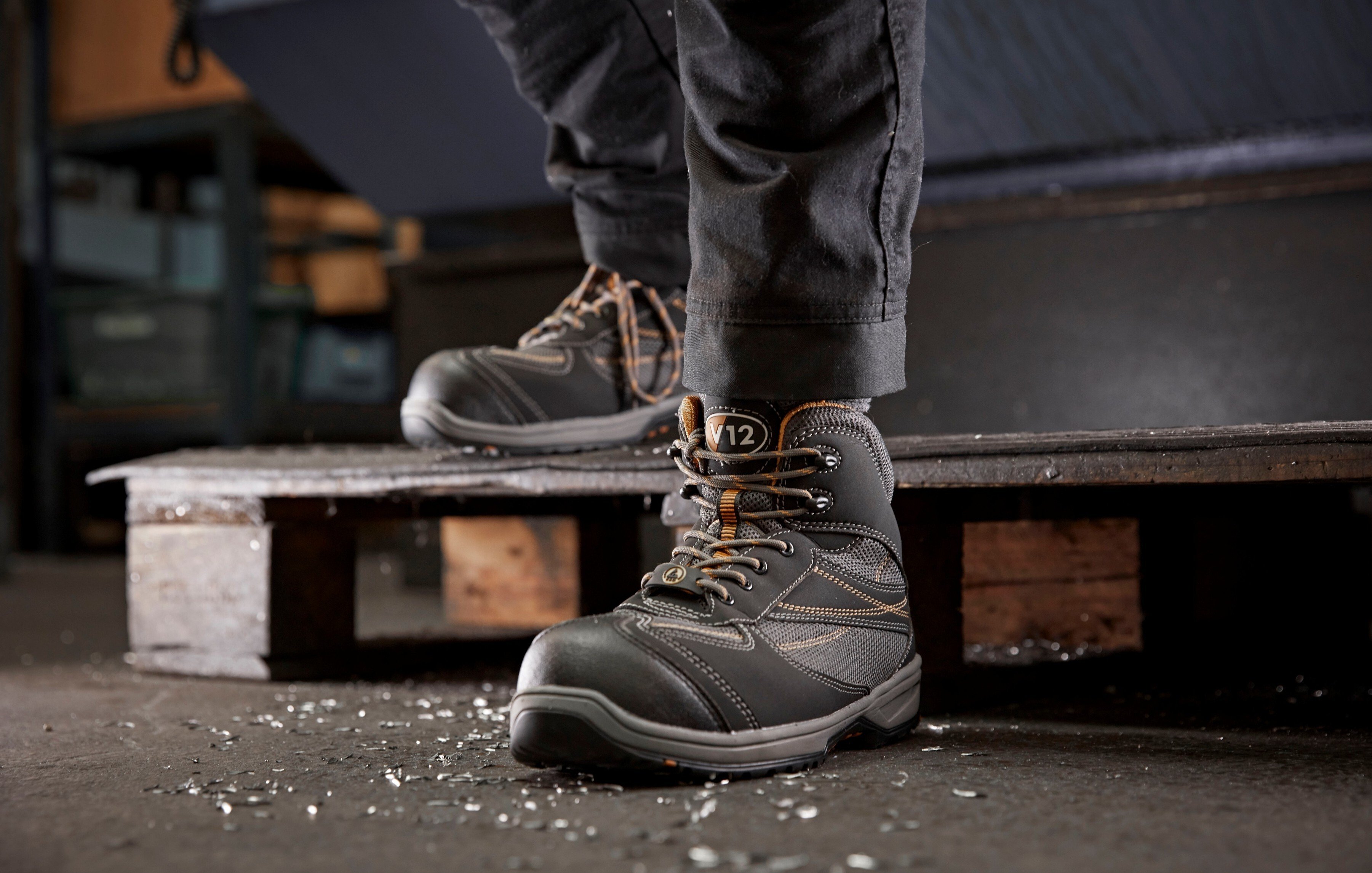You'd be forgiven for thinking that the upper of a shoe or boot is just the part at the top or the section near the ankle. In fact, the upper of a boot or shoe is actually any part above the sole - so this includes the vamp (the front part) the quarter (the back) the counter (material above the heel), and even the tongue. To put it another way, the upper is any part of the boot that wraps around your foot. Without the upper, you'd basically have a flip-flop.
So because the upper is such a major part of your boot, choosing the right one is important. In this article, we're going to answer a question we often get asked: what’s the difference in the materials you use in your uppers? We’ll take you through the various types of uppers available in the V12 range, explain why we use the materials we use, and help you choose the right one based on the environment you work in.
LEATHER
The most popular material for the upper of a boot tends to be leather. In fact, according to leather manufacturer Mahi, over half of all leather consumed globally goes into footwear.
Worth remembering:
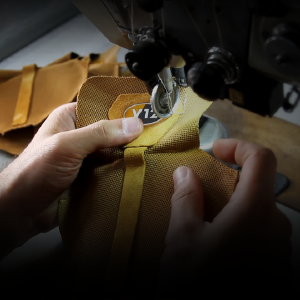
Leather is a biproduct of meat production. While a huge amount of leather is used for footwear and apparel, it is accessed after the animal has been killed for its meat. No animal loses its life specifically to supply leather for V12 footwear.
Now if you think there's only one type of leather, you'd be mistaken. There are several different ways leather can be enhanced, treated or modified to create various levels of strength and different looks.
An important thing to consider about leather is that it comes from animals – from living breathing entities, and this fact affects the way it behaves and can be treated. Even after the skin has been removed from the animal, tanned, processed and used in footwear as leather, it retains many of the qualities of skin – it has pores, produces natural oils, and it needs looking after.
Let's learn more about the different types used in our uppers.
FULL GRAIN LEATHER
Full grain leather is the highest quality and most durable type of leather, because it’s the full grain of the hide. This means no part of the leather is sanded, split or rubbed down. As it's been left in its natural state, full grain leather remains very tight and robust, and has strong, natural water resistance.
Why choose a safety boot with full grain leather uppers?
Benefits:
Full grain leather is thick and strong, and so is durable and naturally tear-resistant. Because of this, people working with contaminants or chemicals often choose this material for their uppers, as well as people in grounds management. Furthermore, many think that as a full grain leather product is used and handled, it actually improves due to the attractive veneer that develops over time.
Things to consider:
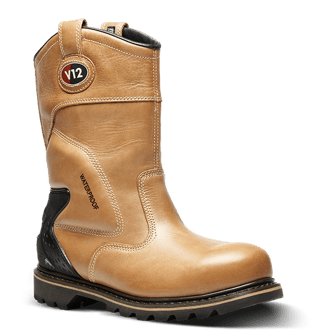
Full grain leather is, due its premium quality, typically the most expensive leather. Furthermore, because full grain leather is not treated or changed in any way other than being dyed, it’s sometimes possible to see the original marks the animal had on its skin such as scars and even insect bites. While some may not appreciate these inconsistencies in the material, others see them as sign of authenticity and natural beauty.
AN UPPER AT WORK
V1250 Tomahawk is made from full grain vintage cowhide leather. Coupled with its heavy-duty triple stitching, ankle padding and reinforced pull-on loops, it’s a seriously durable rigger boot.
CRAZY HORSE
We get the term ‘crazy horse’ because this type of leather was used predominantly to produce horse saddles. Allegedly it earnt its label ‘crazy’ because it could be used wildly and roughly and still retain its strength and durability. Crazy horse is leather which has had a special wax applied to its surface. This process enhances the leather fibres and when they are scratched or rubbed, the shade of the leather's natural colour changes to create an attractive, vintage appearance.
Why choose a safety boot with crazy horse uppers?
Benefits:
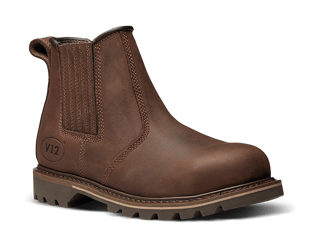
Leather treated with oil has the advantage of being splash - and in some cases stain - resistant, which is why it’s favoured by wearers in outdoor industries such as agriculture.
As well as this, many enjoy the antique or vintage look the leather gets due to the way it’s treated, and some also feel that the leather improves in appearance over time.
AN UPPER AT WORK
V12's best selling dealer boot, V1231 Rawhide, is made of oiled crazy horse leather, ensuring an extremely durable, water-resistant and breathable construction along with an iconic, elegant look.
PULL-UP LEATHER
Also referred to as waxy or oily pull-up leather, this material is a lot like crazy horse in that it gets treated to give the leather a specific look. Pull-up leather is treated with oils, waxes and dyes in a way that means when the material is pulled or stretched during use, the finish becomes lighter in these particular areas.
Why choose a safety boot with pull-up uppers?
Benefits:
Many enjoy the rustic and rough look pull-up leather gives to boots, and overtime, the leather can soften to improve the level of comfort.
Things to consider:
Much like crazy horse, pull-up leather can sometimes leave people a little disappointed if they were hoping for a consistent looking leather, rather than a smooth appearance. Often companies put a disclaimer on products which feature this type of leather that it is a natural product and may vary from the photo and indeed from pair to pair. If you're after a consistent, uniform boot, this type of leather might not be for you.
NUBUCK
Nubuck is leather which is sanded down and lightly buffed on the outer surface of the skin. This gives it a soft, velvety feel, which creates an attractive and stylish look. Some prefer it to suede because it has a finer nap.
Why choose a safety boot with Nubuck uppers? 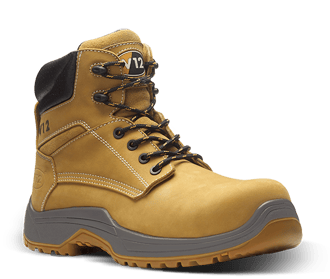
Benefits:
Like full grain products, leather comes from organic material, so it biodegrades more easily, and it’s also long-lasting and relatively durable because the grain layer retains its strong and tight fibres.
Things to consider:
People often consider Nubuck and suede to be very similar or even interchangeable, but Nubuck is often water-repellent while suede tends not to have particularly strong water-resistant properties.
AN UPPER AT WORK
Above: VR602.01 Puma IGS is made from honey Nubuck. Its deep padded scoop collar and bound bellows tongue gives the wearer extra strength and comfort.
CORRECTED GRAIN LEATHER
Corrected leather uppers are made by taking full grain leather and splitting it horizontally to make two usable layers. This is often done so manufacturers have more material to work with. Because the new split layer is thinner and less strong, it's coated with a particular finish to enhance its strength. It's often printed with a pattern which mimics the look and feel of natural leather.
Benefits:
As corrected grain leather is the result of a more economical process and features less genuine leather, it is less expensive.
Things to consider:
Because a layer has been split or shaved off, while it gets additional durability from the coating applied to it, corrected leather doesn't have the strength of full grain leather. Furthermore, because of its synthetic coating, corrected leather is often a lot less breathable than more premium leathers, which can lead to hot and sweaty feet.
SYNTHETIC UPPERS
Synthetic uppers are made from non-leather materials, and while these materials generally consist of PU or PVC, advances in technology are introducing an increasing amount of innovative alternatives to animal skin. Synthetic alternatives to leather are also known as faux leather or vegan leather (because no animal hide is used as the upper material).
Did you know?
In Portugal, it is now illegal for leather manufacturers to label non-animal skin materials as ‘vegan’ or ‘synthetic’ leather. The term has been deemed misleading and one that does not offer consumers a clear or accurate description of non-leather materials – and is an initiative that several other countries are implementing.
Read more on this topic in the article from Green Queen here.
Now that sustainability and animal welfare are higher on many people’s agenda, more clothing and footwear manufacturers are developing leather-free uppers.
Why choose a safety boot with synthetic uppers?
Benefits:
Some enjoy the fact that synthetic material doesn't mark as easily as natural leather, and because it doesn’t come from an animal, these uppers have none of the imperfections which appear in leather, which is an aesthetic benefit to many. This fact also means that synthetic uppers tend to feature a lot less waste - the material is consistent and features no potential lower quality areas that need to be cut away and discarded, unlike real leather.
Because of advances in product development, good quality synthetic uppers can still provide breathability and give the wearer plenty of flexibility. Many also like the fact that synthetic uppers offer good abrasion and chemical resistance, and tend also to be more lightweight. This is a particular bonus if working in an industry environment where there is a lot of standing, walking or fast-paced movement such as kitchens or warehouses.
Things to consider:
Some feel it’s better for the planet that leather isn’t used for products, as this would establish a more compassionate and humane relationship with animals, but equally, a lot of synthetic material like PVC or PU takes far longer to biodegrade than leather, so in this case it's arguable it is has a more negative environmental effect. Ultimately, it depends on people’s perception and definition of ‘sustainability.’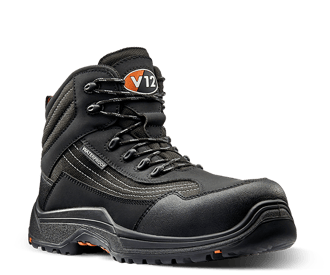
AN UPPER AT WORK
The V1501.01 Caiman IGS is a great example of how synthetic uppers can make a highly effective safety boot and in no way compromise the wearer’s comfort or safety experience. Its advanced microfibres create a nubuck-like feel, while its waterproof lining allows breathability and reduces perspiration.
Watch how Caiman performs in a range of environments below.
Congratulations – you've just graduated from the V12 Uppers Academy. Now you know your full grain from your top grain and your leather from your synthetic, hopefully when making a safety boot choice, you’ll be able to factor in uppers as a key part of what informs your purchase. Because when an understanding of upper material is combined with the knowledge of a style’s safety spec, comfort features and slip resistance, this can benefit the longevity of the product, and ultimately, you’ll be able to pick a boot that does its job, so you can do yours.

